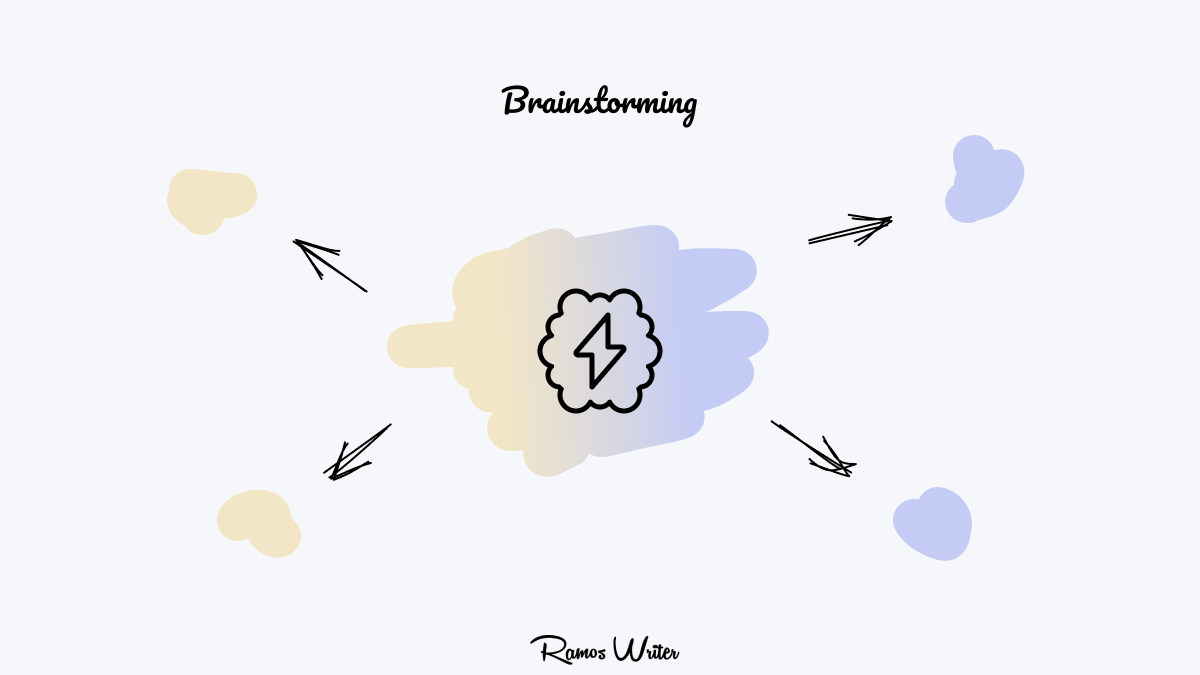What is brainstorming in writing? (Tips & Examples)
Use this strategy to become an idea machine.

Ideas are the lifeblood of creative work. Whether you're a writer, an artist, or any similar role, your job relies on providing a steady stream of original output. This is where the practice of brainstorming comes into play.
Brainstorming is a type of idea generation activity that enables people to produce a large number of ideas quickly.
This article will dive into how it works, explain the different types you can use, and end with a few examples to guide your work.
How does brainstorming work?

Think about the last time you solved a problem in your head. It probably went something like this: you encountered the issue, immediately thought of 1-2 clear solutions, considered each briefly, and then chose the best option.
If the above process includes four steps, brainstorming focuses exclusively on step #2 where the goal is to think of possible solutions to a problem.
However, it differs from normal problem-solving because participants are not supposed to validate or choose an option. All the energy goes towards a single goal: identifying as many ideas as possible within the time and creative constraints.
What types of brainstorming are there?
There is an endless variety of ways you could ideate, but my favorites tend to be the simplest. Here are a few of the most common ones.
- Freewriting — Writing down related and unrelated words allows your brain to make new connections. No need for good grammar or punctuation; just get those words onto a page!
- Clusters — Start by writing down 3-6 “topics” on a page, leaving ample space between each, and freewrite around each one to see what new ideas spring up.
- Diagrams and charts — Instead of using words to explain your ideas, draw pictures illustrating how an idea could work. Whiteboards are an excellent tool for this.
- Worst idea — An inverse of traditional brainstorming where you list out "bad" ideas. The goal is to eliminate these options while being open to unforeseen opportunities.
Any of these activities can be done in a group or alone. Although, research shows that the best method is to have individuals brainstorm independently first and then come together to share and ideate further as a group. Psychologists have proven this reduces groupthink.
Another nuance I like to point out is that my suggestions don't include activities like making pros and cons lists or SWOT tables. That's because these tend to push people to evaluate their ideas, which is not the goal of brainstorming. There will be room for that later, but when we try to analyze and refine our ideas too early, we limit our efforts.
Examples of brainstorming
To help bring these ideas to life, I want to share the following video with you. In it, the illustrators highlight six brainstorming tactics you can try right away.
The examples shown in the video include:
- Mind mapping
- Right braining
- Provocative action
- Break and build
- Pessimist versus optimist
- Randomness
Brainstorming tips for new writers
Finally, let’s close with a few strategies you can use to make brainstorming an integral part of your writing process.
- Keep a dedicated notebook. It's easy for ideas to get scattered. My solution is to keep a ruled notebook near my desk for all my ideas. I avoid using it for anything else and divide it into project-related sections to keep it organized.
- Use the Notion app. For those who prefer a digital solution, Notion is an excellent alternative to a physical notebook.
- Throw away old notes. During my first few years as a writer, I was terrified of losing a good idea. So, I kept every notebook and scrap of paper in the hopes of keeping every random idea within arm's reach. As you might imagine, this wasn't helpful at all, and I carried around a low level of cognitive overload for no reason. Now, I throw away all of my notes at the end of every year, and I've yet to run out of ideas!
- Create a commonplace book. My one exception for keeping old notes is if you're working on a large project that will take more than a year to complete (like a book). I've personally found Ryan Holiday's commonplace book to be a satisfactory middle ground.
- Practice regularly. Brainstorming is a muscle, and like any muscle — the more you use it, the stronger it will get!
If you found this article helpful, subscribe for more tips on how to improve and monetize your writing work. Happy brainstorming!
